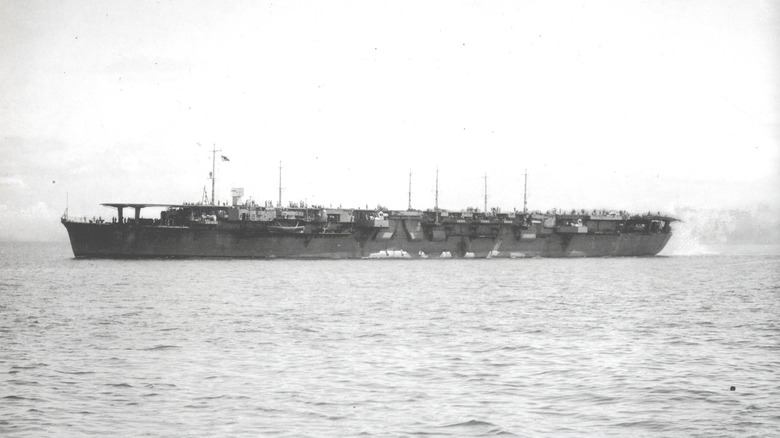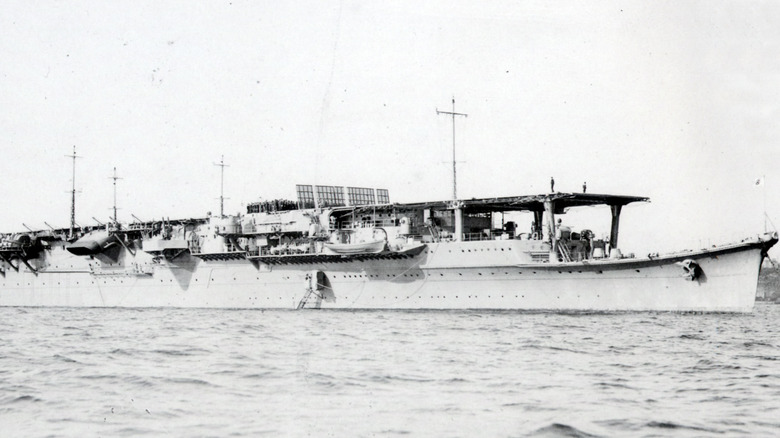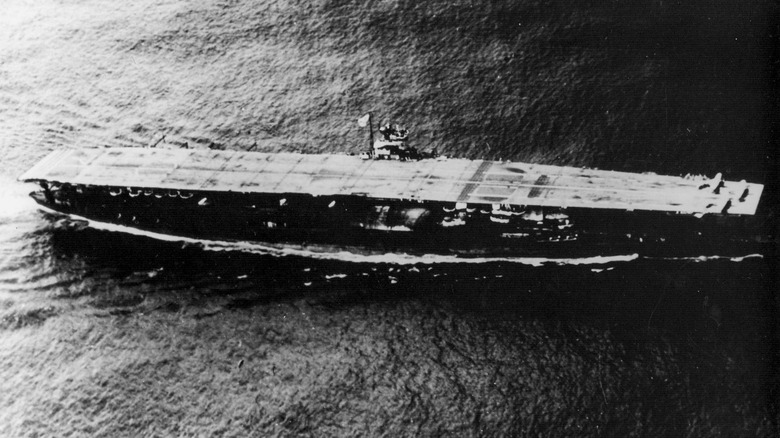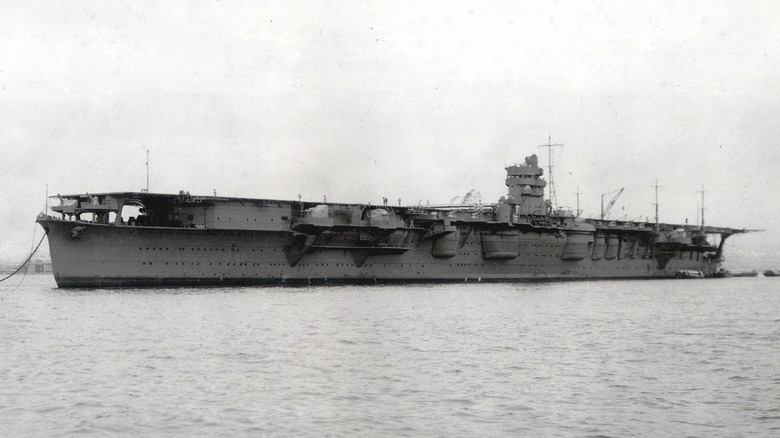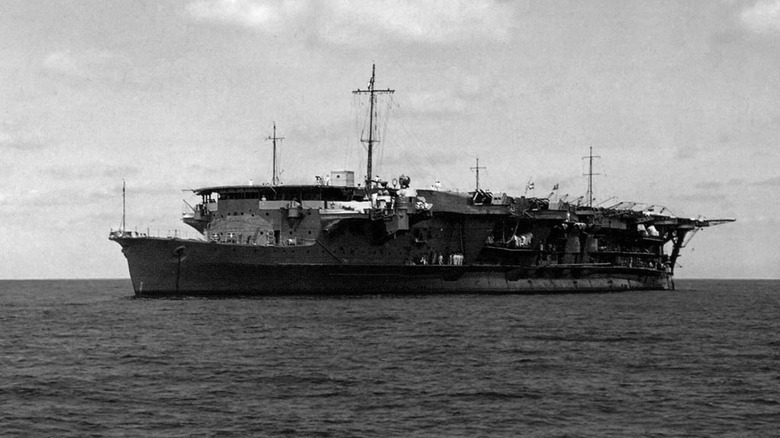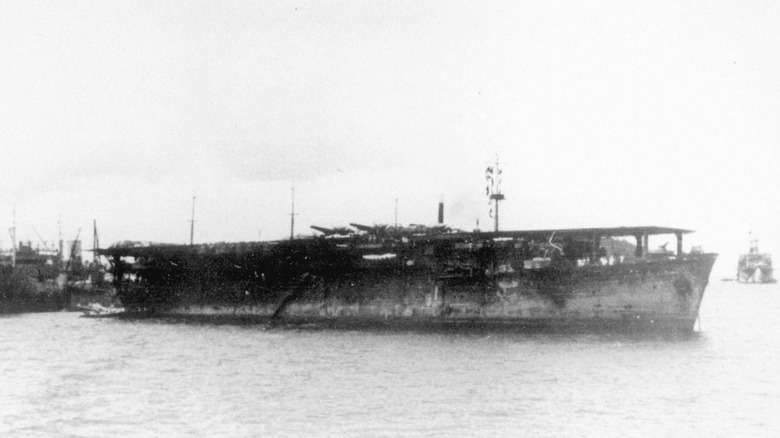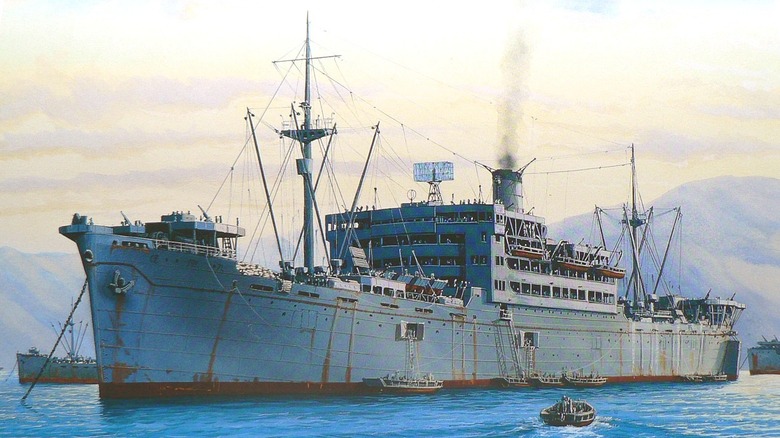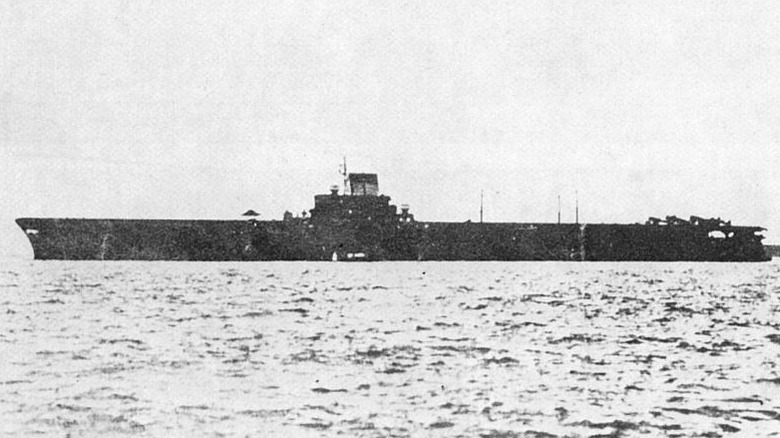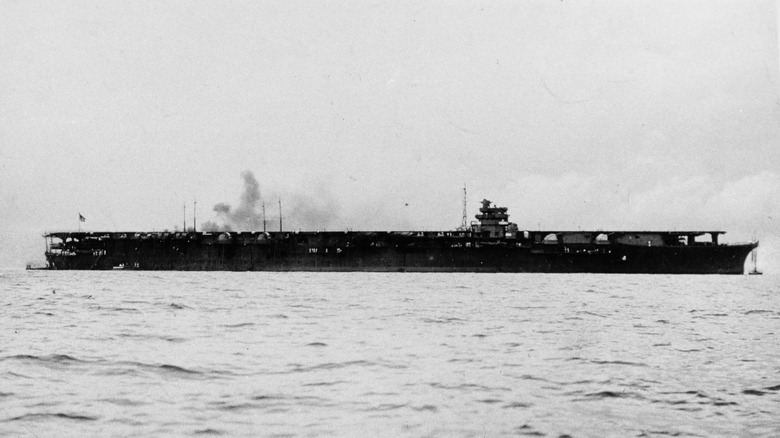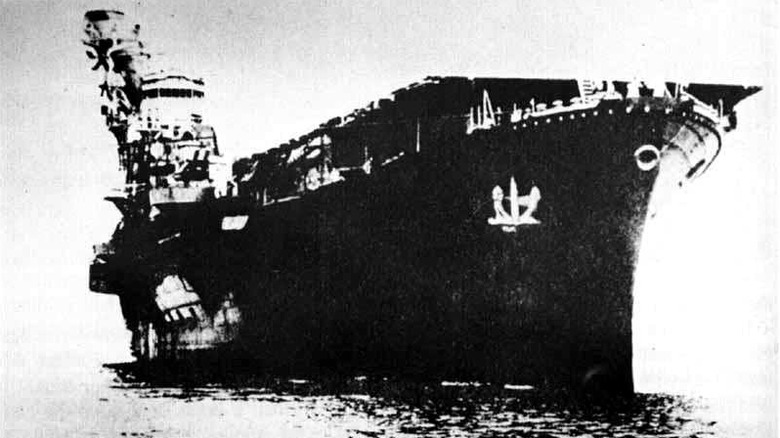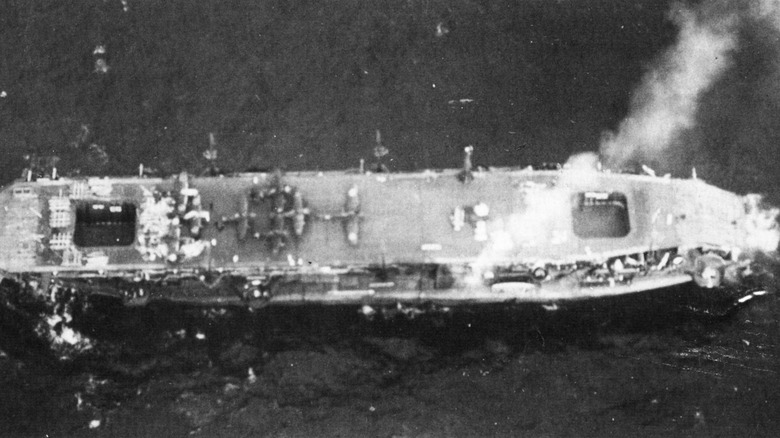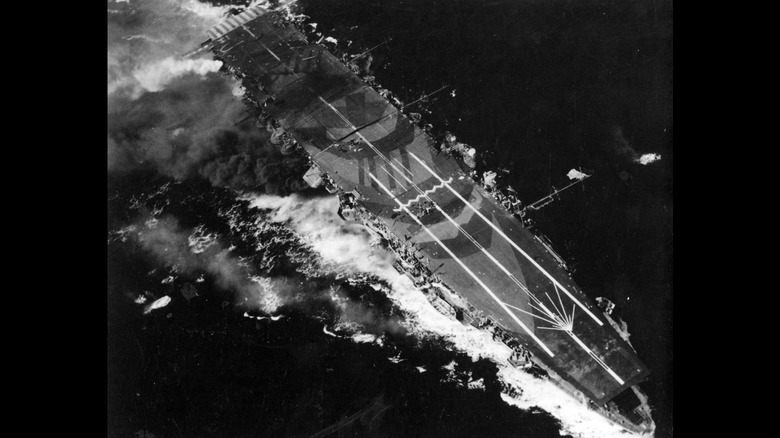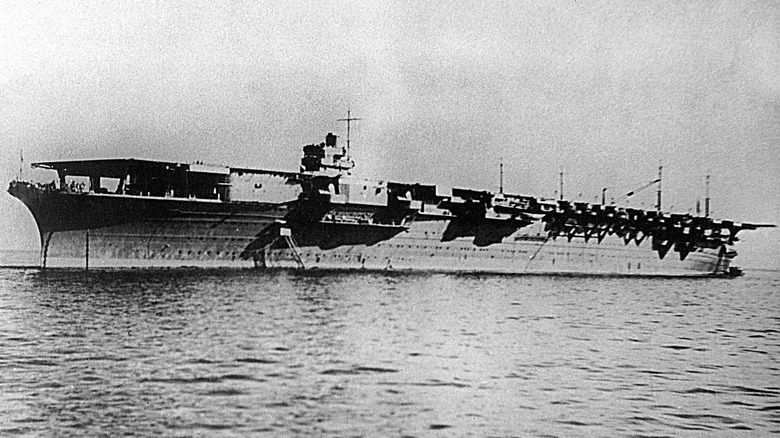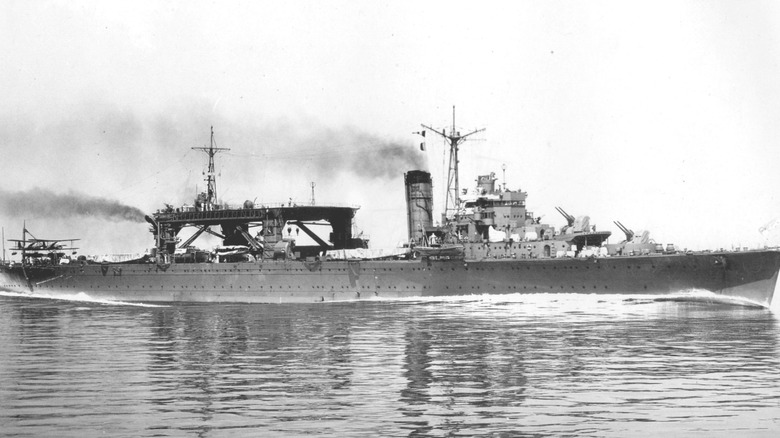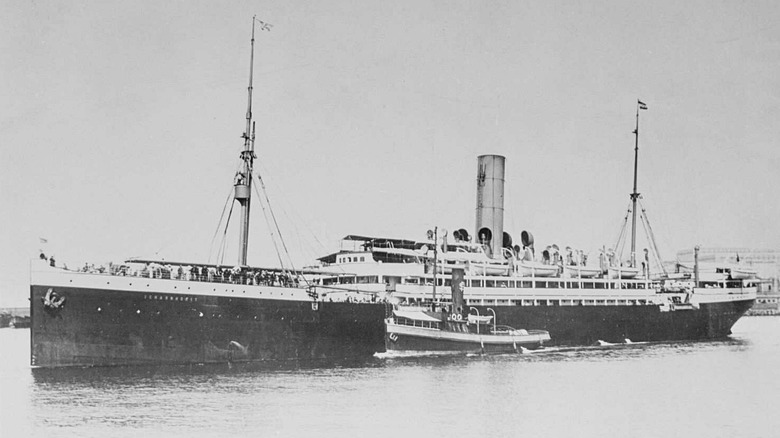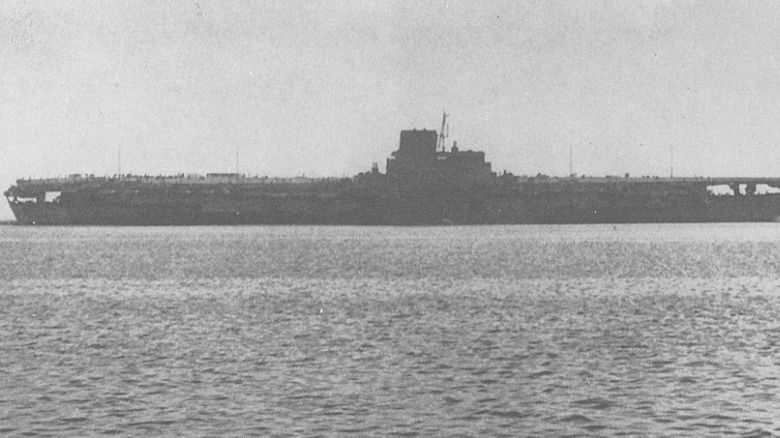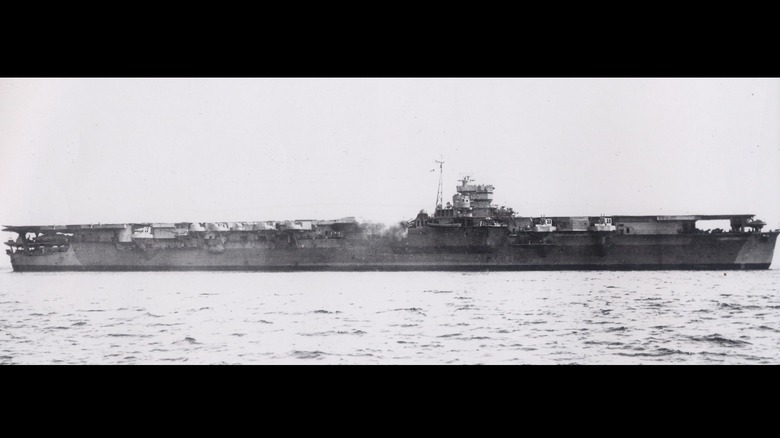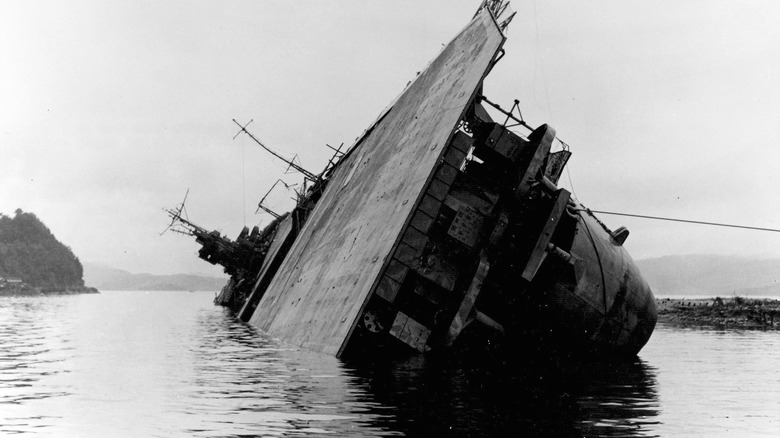Every Japanese Aircraft Carrier Sunk In WWII
World War II, true to its name, was fought across many fronts, with battles raging around the world over land, sea, and air. In the Pacific theater, especially, the Japanese and Allied military fought large naval battles that incorporated both powerful battleships and aircraft carriers that carried many fighter planes.
Over the course of World War II, dozens of these massive carriers met their final fate at the bottom of the Pacific Ocean or some other body of water. Let's take a look at Japanese aircraft carriers that were destroyed during World War II.
Shōhō
Many Japanese aircraft carriers were designed to be converted to different types of ships based on the needs of the Navy. Shōhō was one such ship. Originally a submarine tender support ship, it was refitted into a light carrier just in time to be sunk during the Battle of the Coral Sea.
The battle saw Shōhō taken down by dive bombers coming from a pair of American fleet carriers, Lexington and Yorktown. All told, 631 of the ship's 834 sailors were killed. As for the Lexington, it didn't survive the Battle of the Coral Sea, while the Yorktown would meet its final fate during the Battle of Midway.
Akagi
In early June 1942, the Battle of Midway was an attempt by the Japanese to finish the job they started at Pearl Harbor. At the Hawaiian base, numerous American battleships were utterly destroyed, but American aircraft carriers were away on missions at the time. One of Japan's greatest follies during the war was its early reliance on battleships like Yamato and Musashi, rather than recognizing that aircraft carriers would ultimately be responsible for victory in the Pacific theater.
America came ready to fight at Midway, ultimately turning Japan's trap into one of its own. Four Japanese carriers went down that day, including the Akagi, which was decimated by a dive bombing run led by Dick Best, whose bomb penetrated the flight deck and exploded inside the ship, destroying it from the inside out.
Kaga
Another Japanese carrier taken out during the Battle of Midway was the Kaga, which fell prey to a barrage of bombs dropped by a squadron led by C. Wade McClusky. However, most carriers were vulnerable to damage from above thanks to weak anti-air defenses, as well as the bravery of daring pilots like McClusky and Dick Best, who turned dive bombing into an art.
Dive bombing runs were the go-to method of taking down enemy carriers, since torpedoes were notoriously unreliable. As testament to this fact, the American submarine, Nautilus, launched four torpedoes at the Kaga during the battle. The first torpedo got stuck and failed to launch, the second and third missed entirely, and the fourth struck the hull, but failed to detonate. Four torpedoes, zero damage. Fortunately, dive bombers stepped in.
Sōryū
Aircraft carriers with a full complement of armed fighter planes are nothing short of a powder keg. When the Sōryū was struck by American dive bombers during the Battle of Midway, many fighter planes were still onboard. When the dive bombers hit the target, the whole ship was engulfed in flames, since it wasn't just the initial bomb that detonated, but also the bombs and fuel on all the fighters that had yet to take off.
The Sōryū's captain, Ryusaku Yanagimoto, chose not to abandon his duty. He went down with his ship as the carrier slowly sank to the bottom of the Pacific Ocean, one of the over 3,400 sailors across both sides who died in the battle.
Hiryū
The Battle of Midway ended with the American Navy regrouping for one last dive bombing run against the last Japanese carrier, the Hiryū. The attack was led by Dick Best, and Midway would cement his place in history as one of the only people to land a successful dive-bombing attack on two targets in one day.
Midway was a turning point for the war in the Pacific. It was intended to wipe the American Navy off the map for good, but instead had the opposite effect, with Japan losing a total of four aircraft carriers, evening the odds and setting the stage for the rest of the war. America was no longer on the back foot, and Japan's early advantage was squandered. The fighting would only get more ferocious from there.
Ryūjō
Months after Midway, fighting intensified at the Solomon Islands. In August 1942, the Battle of the Eastern Solomons was a decisive victory for the American forces. Though the U.S. aircraft carrier Enterprise was damaged in the battle, it lived to fight another day. On the Japanese side, the Ryūjō wasn't so lucky. Several 1,000-pound bombs and one aerial torpedo hit the ship. In a rare development, the torpedo actually worked as intended, causing the Ryūjō to take on water and ultimately capsize and sink.
Ryūjō was not a particularly stable ship when it was initially constructed in 1929. It was discovered that its design was flawed and could not endure rough seas safely, so it was redesigned and refitted to be suitable for war. Fun Fact: Torpedoes and bombs also compromise a ship's sea legs.
Chūyō
The Chūyō was not initially designed to be a warship. It was originally known as Nitta Maru, a passenger liner that was requisitioned by the Japanese government in 1941. Following the disastrous Battle of Midway, Japan initiated a plan to convert several large ships into aircraft carriers. That's how the Nitta Maru became the Chūyō.
On December 4, 1943, Chūyō was struck by multiple torpedoes launched by the submarine USS Sailfish and sank, killing many of the people aboard. Unfortunately, this also included 20 of 21 American POWs who were captured from the wreck of the Sculpin, a submarine that had been sunk over a week earlier, adding a degree of bitter tragedy to what was otherwise a decisive victory.
Nigitsu Maru
The Nigitsu Maru wasn't an aircraft carrier in the literal sense, but in reality it was more of a transport ferry used to move aircraft from one location to another. The Nigitsu Maru was designed alongside its sister ship, the Akitsu Maru (more on that one later), but lacked a flight deck, which limited its utility. Perhaps because of this, the Nigitsu Maru never played a meaningful role in battle.
On January 12, 1944, the submarine USS Hake torpedoed the Nigitsu Maru, hitting it with two of four torpedoes launched. The Nigitsu Maru tried to counterattack with depth charges, assuming that the Hake was deep underwater. However, the Hake was actually on the surface, and managed to take down the Nigitsu Maru with no damage taken itself.
Taihō
The Battle of the Philippine Sea was another decisive American victory. Over 100 Americans were killed in the battle, but the Japanese lost nearly 3,000 sailors and three of their precious carriers, including the Taihō, which was taken down by a torpedo from the submarine USS Albacore. It was a single torpedo, but it did just the right amount of damage, which was exacerbated by the repair team opening the ship's ventilation in an attempt to disperse flammable gas. Instead, it turned the entire ship into a raging inferno.
Vice-Admiral Jisaburō Ozawa intended to go down with his ship, but his crew implored him to live to fight another day. He went on to participate in the Battle of Leyte Gulf later in 1944. The 1,650 men who died aboard the Taihō did not.
Shōkaku
Elsewhere during the Battle of the Philippine Sea, the Shōkaku met its final fate. The Shōkaku had a storied history leading up to its demise, going back to the very beginning of Japan's war against America, which saw the Shōkaku play a role in the attack on Pearl Harbor. During the Battle of the Coral Sea, Shōkaku was crippled by attacks from USS Yorktown's fleet of dive bombers but managed to survive and underwent repairs during the Battle of Midway.
During a refueling stop during the Battle of the Philippine Sea, Shōkaku was hit by multiple torpedoes from the USS Cavalla, resulting in a massive and uncontrollable fire from which the once-formidable ship could not recover. There were 570 survivors, but 1,272 men died on board.
Hiyō
Originally developed as a passenger liner, the Japanese Navy purchased the Izumo Maru in 1940 to be converted into an aircraft carrier. The ship now known as Hiyō was completed in 1942, but not soon enough to participate in the Battle of Midway. Hiyō was supposed to participate in the Battle of Santa Cruz but was waylaid by a fire in the generator room, forcing the ship to return to base for repairs.
Hiyō was damaged multiple times during its service history, but was usually able to recover, repair, and get back into service. That changed during the Battle of the Philippine Sea, when dive bombers from the USS Enterprise and torpedo bombers from the USS Belleau Wood inflicted fatal damage on the ship, killing 247 Japanese sailors.
Taiyō
Taiyō, like some of the other ships on this list, started out as a passenger liner before being acquired by the Japanese government and converted into a warship. It was mostly used for ferrying fighter planes and training exercises. Despite this theoretically low-risk role, Taiyō found itself in many tough scrapes with U.S. submarines. In September of 1942, it was attacked by the USS Trout, and in 1943, it was damaged by the USS Tunny. Later that year, the USS Cabrilla incapacitated the Taiyō, forcing the ship to be towed back to base for repairs.
Taiyō's luck finally ran out in August 1944, when it found itself on the wrong side of a torpedo attack from the submarine USS Rasher, which caused critical damage and destroyed the ship. Of the 1,200 souls aboard, 800 died in the attack.
Unyō
Another passenger liner turned into a weapon of war, the Unyō was originally called the Yawata Maru before it was converted into an aircraft carrier for the war. In January of 1944, Unyō took torpedo damage from the USS Haddock, but managed to survive and undergo repairs.
In September of 1944, Unyō was part of a convoy including multiple oil tankers and escort vessels. The convoy was intercepted by the submarine USS Barb. In a surprise attack, the Barb immediately destroyed the oil tanker Atsusa Maru, and a follow-up volley caused critical damage to the Unyō. The Barb emerged unscathed from the skirmish and went on to survive the war, meeting an unceremonious end in 1975 when it was sold to a scrapping company.
Zuihō
Zuihō was lucky enough to survive the Battle of Midway, but didn't survive to the war's end. It was one of many ships across both sides that sank during the Battle of Leyte Gulf, one of the biggest Naval battles of the entire war. When the dust cleared, the American side lost seven warships, including three carriers. It came at a great cost, but Japanese losses were far greater, as they lost 26 warships, including four carriers.
One of the Japanese carriers lost during the battle was Zuihō, which sank during one of the four main engagements of the Battle of Leyte Gulf, known as the Battle off Cape Engaño. The ship was essentially sacrificed as part of a decoy fleet intended to trick the American fleet into abandoning Leyte Island.
Zuikaku
By the time of the Battle of Leyte Gulf, the Zuikaku was the only surviving carrier from the Pearl Harbor attack. Perhaps that's why it was made the flagship of the decoy fleet sent to lure the American navy into abandoning Leyte Island. It worked, which was bad news for the Zuikaku.
The ship took damage in three waves of American attacks led by Admiral William Halsey. Seeing the writing on the wall, Captain Takeo Kaizuka gave the order to abandon ship, but elected to stay behind and go down with the ship. All told, 843 sailors died in the sinking of the Zuikaku. It may have been a decoy, but it was a costly one for the Japanese.
Chiyoda
Chiyoda started life as a seaplane carrier before being converted to a light aircraft carrier in the wake of the devastating Japanese losses at the Battle of Midway. The ship was destroyed as part of the decoy fleet in the Battle off Cape Engaño.
Chiyoda went down after taking dive-bombing hits and the combined firepower of the USS Wichita, New Orleans, Santa Fe, and Mobile. Of the 1,470 sailors on board the Chiyoda, there were no survivors. Japan's decoy at Leyte was successful, but ultimately proved insufficient to secure a victory in the battle or the war.
Chitose
The Chitose, like its sister ship, Chiyoda, started out as a seaplane carrier before being converted to a full-on aircraft carrier in time for the Battle of the Philippine Sea. It survived that fight, though its roster of airplanes was largely destroyed. It then met its unfortunate destiny as part of the doomed decoy fleet in the Battle of Leyte Gulf.
The Battle of Leyte Gulf was costly on both sides, but absolutely disastrous for the Japanese. After this battle, the Japanese navy was unable to fight in any more major battles. From here, it was just a matter of time before the Japanese would lose, but they still fought to the bitter end, forcing America to pay with blood for every inch, every mile, and every island on the path to mainland Japan.
Akitsu Maru
Like the Nigitsu Maru, the Akitsu Maru was not a Navy vessel. Due to infighting between the Japanese Navy and Army, the Army basically developed its own Navy, with the Maru vessels among its ranks. The Akitsu Maru could launch aircraft, but it didn't have equipment to land them on its deck, so it was mostly used in a support role, ferrying planes to and fro.
In 1943, the Akitsu Maru was attacked by the submarine USS Crevalle, but survived thanks to the torpedoes being duds. On November 15, 1944, the USS Queenfish had better luck, launching four torpedoes at the Akitsu Maru. Two hit their mark, with one of the torpedoes detonating the Akitsu Maru's supply of depth charges. The ship sank, with over 2,000 casualties.
Shin'yō
Several ships on this list started out as Japanese passenger ships. Shin'yō was similar, but was actually a German ocean liner known as Scharnhorst, which was effectively stranded in Japan following the start of WWII. Japan bought the ship from Germany and, following the massive naval losses at Midway, decided to convert the ship into an escort carrier.
Shin'yō had a short career and sank on November 17, 1944, just two days after Akitsu Maru was destroyed. Shin'yō, part of the same convoy, was hit by as many as four torpedoes from a volley of six launched by the USS Spadefish submarine. Roughly 1,000 men were killed on the ship, and estimates for the number of survivors range from 200 to just 130.
Shinano
Shinano started out as a third Yamato-class battleship, alongside Musashi and Yamato itself. However, following the tremendous losses at Midway, it was decided to make Shinano a fleet carrier instead. As such, it was the largest aircraft carrier ever made up to that point in time.
On November 29, just 10 days after it set sail on its first mission to complete its conversion and become battle-ready, Shinano was spotted and attacked by American forces. All it took was a trio of torpedo hits from the submarine USS Archerfish to destroy the largest enemy ship in the entire world. Japan went to great lengths to cover up the destruction of Shinano, but it ultimately wouldn't matter. Japan was going to lose the war.
Unryū
Unryū and its sister ships, Amagi and Katsuragi, were late entrants into the war. The Japanese Imperial Navy planned several carriers of this type, but only three were made. The Amagi would never see proper action (more on that in a bit), and Katsuragi was never even deployed until after the war was over.
Unryū, the only one of these three carriers to actually be deployed on missions, didn't fare much better and was sunk on December 19, 1944, by the USS Redfish submarine. By this point in the war, the Japanese navy was a shell of its former self, and even mighty aircraft carriers were easily picked off by American submarine crews.
Amagi
Amagi wasn't just the final Japanese aircraft carrier to sink. To date, it remains the final aircraft carrier from any nation to be lost in wartime battle. As mentioned above, Amagi was late to the party, joining the Japanese fleet in August of 1944. Ultimately, this was a bit too late for it to be an effective game-changer, and the Japanese knew it. The Amagi never actually entered into any battle scenarios and was hidden on a base in Kure.
However, it wasn't hidden well enough, as it was discovered by American forces who attacked it on July 24, with fighter planes hitting it again and again for several days. By July 29, Amagi was abandoned and left for dead, but American forces kept hitting it until it capsized and ran aground, completely incapacitated.
